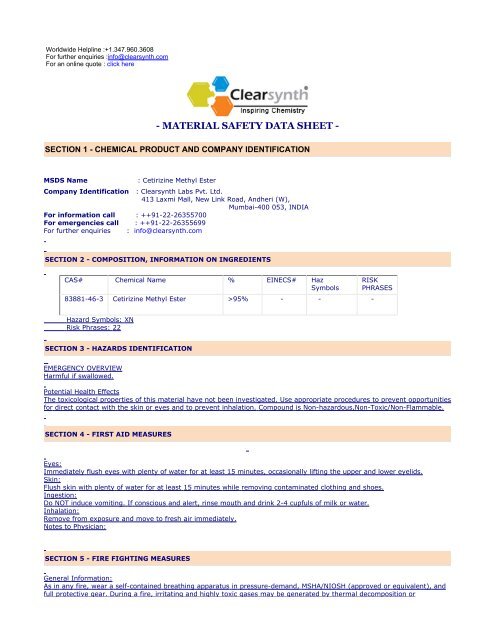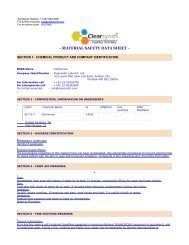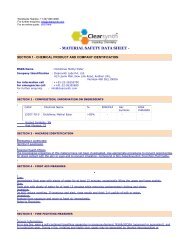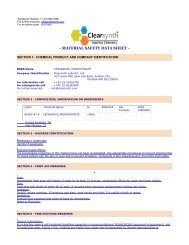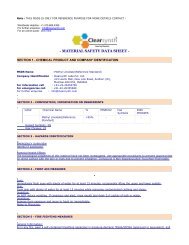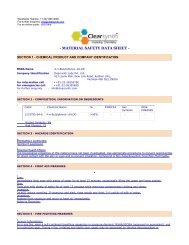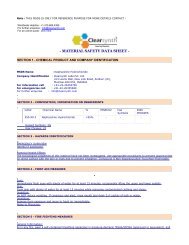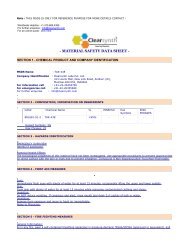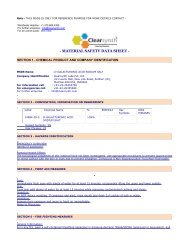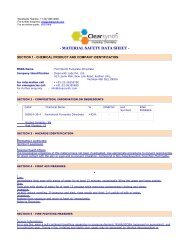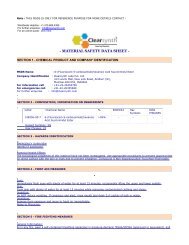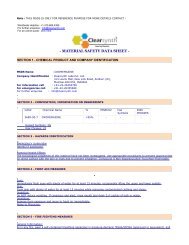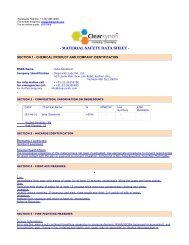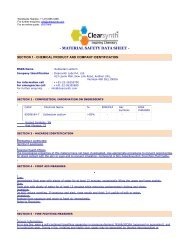MSDS for Cetirizine Methyl Ester - clearsynth
MSDS for Cetirizine Methyl Ester - clearsynth
MSDS for Cetirizine Methyl Ester - clearsynth
Create successful ePaper yourself
Turn your PDF publications into a flip-book with our unique Google optimized e-Paper software.
Worldwide Helpline :+1.347.960.3608<br />
For further enquiries :info@<strong>clearsynth</strong>.com<br />
For an online quote : click here<br />
- MATERIAL SAFETY DATA SHEET -<br />
SECTION 1 - CHEMICAL PRODUCT AND COMPANY IDENTIFICATION<br />
<strong>MSDS</strong> Name<br />
: <strong>Cetirizine</strong> <strong>Methyl</strong> <strong>Ester</strong><br />
Company Identification : Clearsynth Labs Pvt. Ltd.<br />
413 Laxmi Mall, New Link Road, Andheri (W),<br />
Mumbai-400 053, INDIA<br />
For in<strong>for</strong>mation call : ++91-22-26355700<br />
For emergencies call : ++91-22-26355699<br />
For further enquiries : info@<strong>clearsynth</strong>.com<br />
SECTION 2 - COMPOSITION, INFORMATION ON INGREDIENTS<br />
CAS# Chemical Name % EINECS# Haz<br />
Symbols<br />
83881-46-3 <strong>Cetirizine</strong> <strong>Methyl</strong> <strong>Ester</strong> >95% - - -<br />
RISK<br />
PHRASES<br />
Hazard Symbols: XN<br />
Risk Phrases: 22<br />
SECTION 3 - HAZARDS IDENTIFICATION<br />
EMERGENCY OVERVIEW<br />
Harmful if swallowed.<br />
Potential Health Effects<br />
The toxicological properties of this material have not been investigated. Use appropriate procedures to prevent opportunities<br />
<strong>for</strong> direct contact with the skin or eyes and to prevent inhalation. Compound is Non-hazardous,Non-Toxic/Non-Flammable.<br />
SECTION 4 - FIRST AID MEASURES<br />
Eyes:<br />
Immediately flush eyes with plenty of water <strong>for</strong> at least 15 minutes, occasionally lifting the upper and lower eyelids.<br />
Skin:<br />
Flush skin with plenty of water <strong>for</strong> at least 15 minutes while removing contaminated clothing and shoes.<br />
Ingestion:<br />
Do NOT induce vomiting. If conscious and alert, rinse mouth and drink 2-4 cupfuls of milk or water.<br />
Inhalation:<br />
Remove from exposure and move to fresh air immediately.<br />
Notes to Physician:<br />
SECTION 5 - FIRE FIGHTING MEASURES<br />
General In<strong>for</strong>mation:<br />
As in any fire, wear a self-contained breathing apparatus in pressure-demand, MSHA/NIOSH (approved or equivalent), and<br />
full protective gear. During a fire, irritating and highly toxic gases may be generated by thermal decomposition or
combustion.<br />
Extinguishing Media:<br />
In case of fire, use water, dry chemical, chemical foam, or alcohol-resistant foam.<br />
SECTION 6 - ACCIDENTAL RELEASE MEASURES<br />
General In<strong>for</strong>mation: Use proper personal protective equipment as indicated in Section 8.<br />
Spills/Leaks:<br />
Clean up spills immediately, observing precautions in the Protective Equipment section. Sweep up, then place into a suitable<br />
container <strong>for</strong> disposal.<br />
SECTION 7 - HANDLING and STORAGE<br />
Handling:<br />
Wash thoroughly after handling. Remove contaminated clothing and wash be<strong>for</strong>e reuse. Avoid contact with eyes, skin, and<br />
clothing. Avoid ingestion and inhalation.<br />
Storage:<br />
Store in a well closed container.<br />
SECTION 8 - EXPOSURE CONTROLS, PERSONAL PROTECTION<br />
Engineering Controls:<br />
Use adequate general or local exhaust ventilation to keep airborne concentrations below the permissible exposure limits.<br />
Use process enclosure, local exhaust ventilation, or other engineering controls to control airborne levels.<br />
Personal Protective Equipment<br />
Eyes:<br />
Wear safety glasses and chemical goggles if splashing is possible.<br />
Skin:<br />
Wear appropriate protective gloves and clothing to prevent skin exposure.<br />
Clothing:<br />
Wear appropriate protective clothing to minimize contact with skin.<br />
Respirators:<br />
Wear a NIOSH/MSHA or European Standard EN 149 approved full-facepiece airline respirator in the positive pressure mode<br />
with emergency escape provisions.<br />
SECTION 9 - PHYSICAL AND CHEMICAL PROPERTIES<br />
Physical State:<br />
Pale Yellow Oil<br />
Molecular Formula:<br />
C22H27ClN2O3<br />
Molecular Weight:<br />
402.91<br />
SECTION 10 - STABILITY AND REACTIVITY<br />
Chemical Stability:<br />
Stable under normal temperatures and pressures.<br />
Conditions to Avoid:<br />
Incompatible materials, strong oxidants.<br />
Incompatibilities with Other Materials:<br />
Strong oxidizing agents, strong bases.<br />
Hazardous Decomposition Products:<br />
Nitrogen oxides, carbon monoxide, irritating and toxic fumes and gases, carbon dioxide, nitrogen.<br />
Hazardous Polymerization: Has not been reported.<br />
SECTION 11 - TOXICOLOGICAL INFORMATION
RTECS#:<br />
CAS#: LD50/LC50:<br />
CAS#:Draize test, rabbit, eye: 100 mg/24H Moderate; Oral,<br />
mouse: LD50 = 300 mg/kg; Oral, rabbit: LD50 = 3200 mg/kg; Oral, rat:<br />
LD50 = 980 mg/kg.<br />
Carcinogenicity:<br />
Salicylamide -<br />
Not listed by ACGIH, IARC, NIOSH, NTP, or OSHA.<br />
See actual entry in RTECS <strong>for</strong> complete in<strong>for</strong>mation.<br />
SECTION 12 - ECOLOGICAL INFORMATION<br />
SECTION 13 - DISPOSAL CONSIDERATIONS<br />
Dispose of in a manner consistent with federal, state, and local regulations.<br />
SECTION 14 - TRANSPORT INFORMATION<br />
IATA<br />
IMO<br />
ID/ADR<br />
No in<strong>for</strong>mation available.<br />
No in<strong>for</strong>mation available.<br />
No in<strong>for</strong>mation available.<br />
SECTION 15 - REGULATORY INFORMATION<br />
European/International Regulations<br />
European Labeling in Accordance with EC Directives<br />
Hazard Symbols: XN<br />
Risk Phrases:<br />
R 22 Harmful if swallowed.<br />
Safety Phrases:<br />
WGK (Water Danger/Protection)<br />
CAS# United Kingdom Occupational Exposure Limits<br />
United Kingdom Maximum Exposure Limits<br />
Canada<br />
CAS# is listed on Canada's DSL List.<br />
CAS#is not listed on Canada's Ingredient Disclosure List.<br />
Exposure Limits<br />
US FEDERAL<br />
TSCA<br />
CAS# is listed on the TSCA inventory.<br />
SECTION 16 - ADDITIONAL INFORMATION<br />
The in<strong>for</strong>mation above is believed to be accurate and represents the best in<strong>for</strong>mation currently available to us. However, we<br />
make no warranty of merchantability or any other warranty, express or implied, with respect to such in<strong>for</strong>mation, and we<br />
assume no liability resulting from its use. Users should make their own investigations to determine the suitability of the<br />
in<strong>for</strong>mation <strong>for</strong> their particular purposes. In no way shall the company be liable <strong>for</strong> any claims, losses, or damages of any<br />
third party or <strong>for</strong> lost profits or any special, indirect, incidental, consequential or exemplary damages, howsoever arising,<br />
even if the company has been advised of the possibility of such damages.<br />
------------------------------------------------------------------------------------------------------------


